ThisiscontentfromElsevier'sDrugInformation
Alprostadil
Learn more about Elsevier's Drug Information today! Get the drug data and decision support you need, including TRUE Daily Updates™ including every day including weekends and holidays.
0.05 to 0.1 mcg/kg/minute continuous IV or intra-arterial (umbilical) infusion, initially. Titrate dose to target clinical response (i.e., increased partial pressure of oxygen in infants with restricted pulmonary blood flow or increased systemic blood pressure and blood pH in infants with restricted blood flow), then reduce the dose to the lowest possible dose that maintains the response. Dose may be decreased from 0.1 to 0.05 to 0.025 to 0.01 mcg/kg/minute. Usual dose: 0.01 to 0.1 mcg/kg/minute.[30848] 0.01 to 0.02 mcg/kg/minute may maintain patency while minimizing the risk of apnea.[63412] [64934] Max: 0.4 mcg/kg/minute; however, high infusion rates do not usually produce greater effects and have a higher incidence of adverse effects.[30848]
0.05 to 0.1 mcg/kg/minute continuous IV or intra-arterial (umbilical) infusion, initially. Titrate dose to target clinical response (i.e., increased partial pressure of oxygen in infants with restricted pulmonary blood flow or increased systemic blood pressure and blood pH in infants with restricted blood flow), then reduce the dose to the lowest possible dose that maintains the response. Dose may be decreased from 0.1 to 0.05 to 0.025 to 0.01 mcg/kg/minute. Usual dose: 0.01 to 0.1 mcg/kg/minute.[30848] 0.01 to 0.02 mcg/kg/minute may maintain patency while minimizing the risk of apnea.[63412] [64934] Max: 0.4 mcg/kg/minute; however, high infusion rates do not usually produce greater effects and have a higher incidence of adverse effects.[30848]
NOTE: Alprostadil intracavernous and intraurethral options are second-line treatments for ED per guidelines.[55926]
2.5 mcg initially, injected into the corpus cavernosa, adjusting the dosage by 2.5 mcg increments, to 5 mcg, then by 5 mcg increments according to patient response. Maximum 60 mcg/dose. Do not administer more than 3 times per week, with a minimum of 24 hours between doses.[30849] [61405]
2.5 mcg initially, injected into the corpus cavernosa. If there is a partial response, may be increase by 2.5 mcg to 5 mcg and then in 5 to 10 mcg increments according to patient response until the dose producing an erection suitable for intercourse and not more than 1 hour in duration achieved. If there is no response to the initial 2.5 mcg dose, the second dose may be increased to 7.5 mcg, followed by increments of 5 to 10 mcg. Patient must remain in physician's office until complete detumescence occurs. If there is no response, the next higher dose may be given within 1 hour. If there is a response, wait at least a 1-day interval before giving the next dose. Do not administer more than 3 times per week, with a minimum of 24 hours between doses.[55990]
125 or 250 mcg by intraurethral insertion, initially, as a single dose as needed. Adjust the dose on separate occasions in a stepwise manner until an erection that is sufficient for sexual intercourse is achieved. Dose range: 125 to 1,000 mcg/dose. Max: 2 doses/24 hours.[30847]
1.25 mcg initially, injected into the corpus cavernosa, adjusting the dosage by 2.5 mcg increments, to 5 mcg, then by 5 mcg increments according to patient response. Maximum 60 mcg/dose. Do not administer more than 3 times per week, with a minimum of 24 hours between doses.[30849] [61405]
1.25 mcg initially, injected into the corpus cavernosa. May increase by 1.25 mcg to a dose of 2.5 mcg, followed by an increment of 2.5 mcg to a dose of 5 mcg, and then in 5-mcg increments until a dose producing an erection suitable for intercourse and not more than 1 hour in duration achieved. Patient must remain in physician's office until complete detumescence occurs. If there is no response, the next higher dose may be given within 1 hour. If there is a response, wait at least a 1-day interval before the next dose is given. Do not administer more than 3 times per week, with a minimum of 24 hours between doses.[55990]
Triple drug regimen dose ranges reported in literature: 0.2 to 0.4 mg phentolamine plus 8 to 16 mg papaverine plus 10 to 20 mcg alprostadil per injection.[33055] Although alprostadil monotherapy has a high efficacy rate, reaching up to 70%, triple drug therapy with alprostadil, papaverine, and phentolamine has a response rate of up to 92%. Individual dosages are determined by series of trial injections under physician supervision. Limit use to 1 injection in a 24-hour period, given no more than 3 times per week.[55926] [55992]
Dependent on indication for therapy and product prescribed.
Dependent on indication for therapy and product prescribed.
Safety and efficacy have not been established.
Safety and efficacy have not been established.
Safety and efficacy have not been established.
Doses greater than 0.4 mcg/kg/minute IV of Prostin VR Pediatric are not recommended.
Specific guidelines for dosage adjustments in hepatic impairment are not available; it appears that no dosage adjustments are needed.
Specific guidelines for dosage adjustments in renal impairment are not available; it appears that no dosage adjustments are needed.
† Off-label indication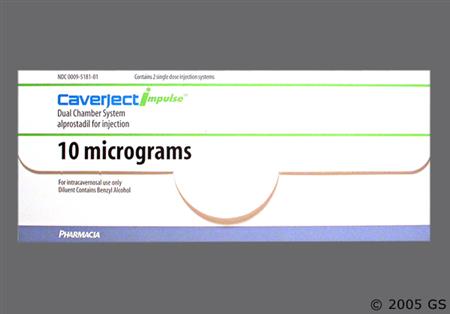
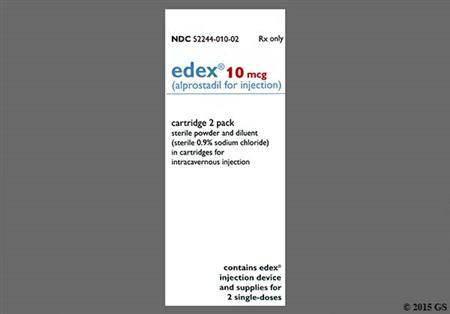
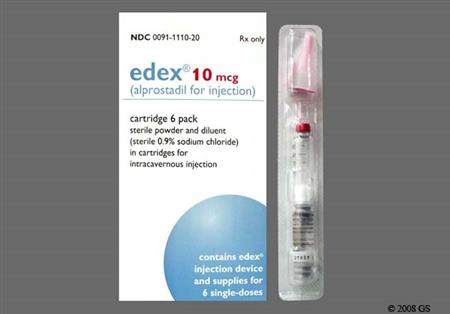
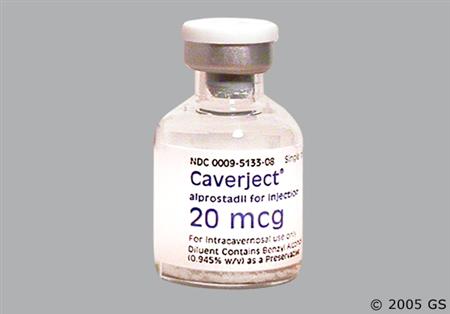
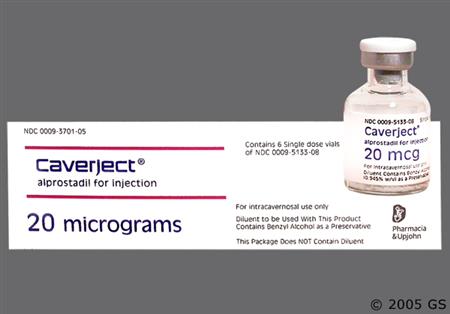

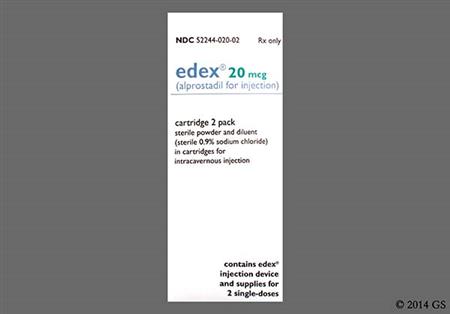
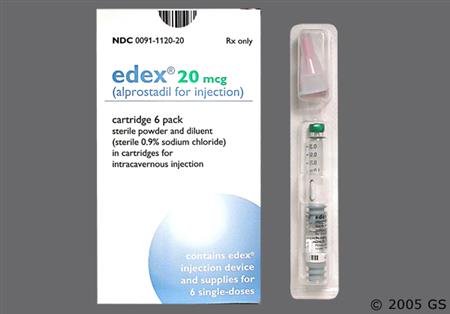
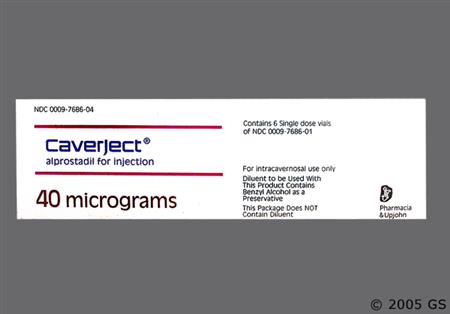
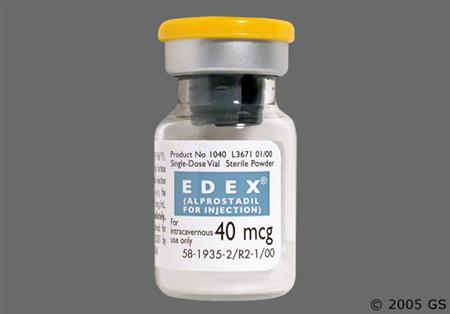
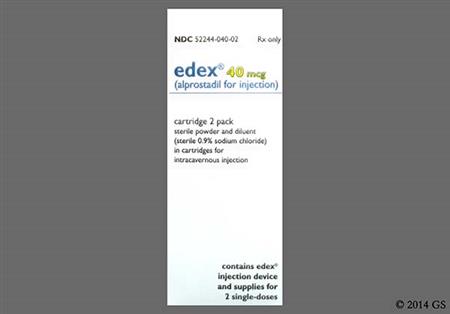
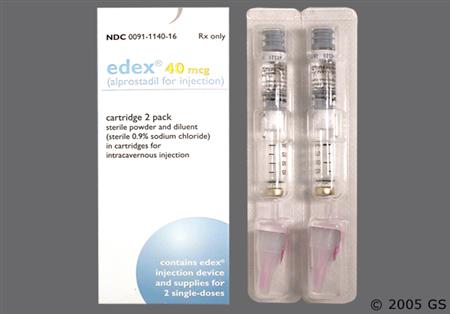

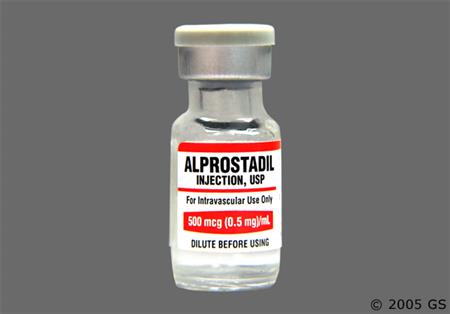
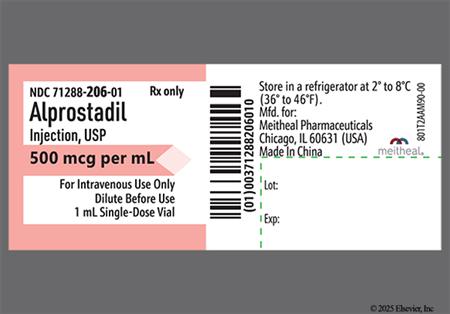
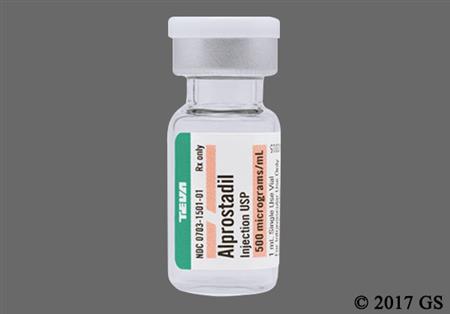

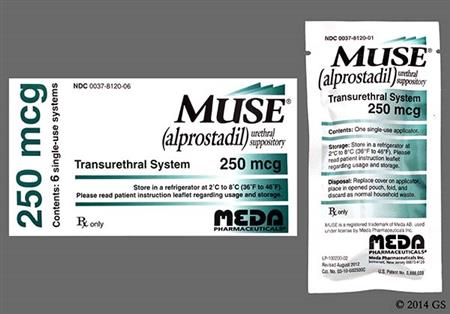

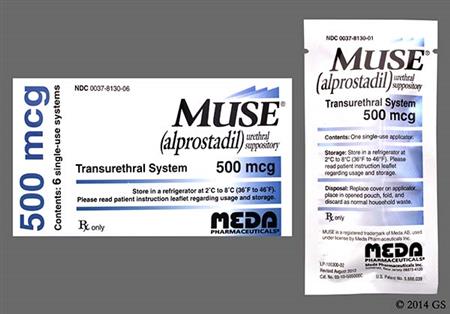
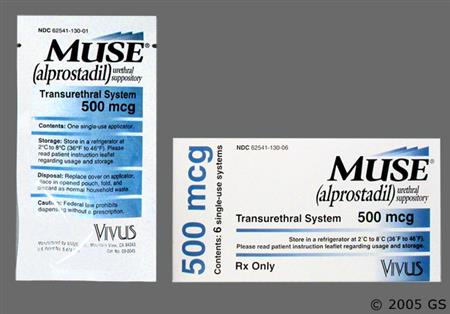
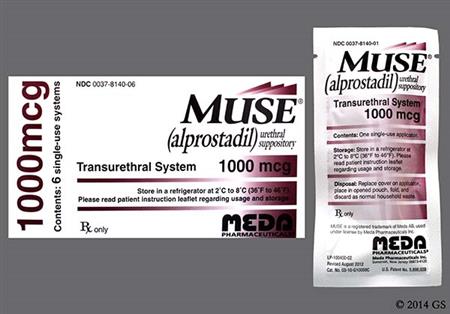
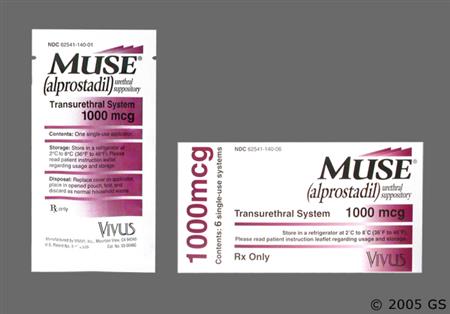
Alprostadil is used to treat erectile dysfunction (ED) in adult males. The efficacy of alprostadil in treating ED varies with the cause; response rate is generally lower in patients with ED due to mixed etiologies compared to those with ED due to neurogenic, psychogenic, or vasculogenic causes. Two dosage forms are marketed for treating ED in adult males: a transurethral product (MUSE) which uses a medicated pellet administered into the urethra, and an injection (Caverject or Edex) that is directly injected into the corpus cavernosa. According to ED treatment guidelines, oral phosphodiesterase type 5 inhibitors (PDE5 inhibitors) are considered first-line therapy. Second-line treatment options include intracavernous injection and intraurethral therapy. Intracavernous injection therapy is the most effective nonsurgical treatment for ED, with predictable and sustained response; however, it is invasive and caries notable side effects including priapism and penile fibrosis.[55926]
Alprostadil is also used for other purposes. Alprostadil and other prostaglandins in the E series are naturally present in the placenta and ductus arteriosus of the fetus. The E-type prostaglandins vasodilate arterioles by direct relaxation of vascular smooth muscle. Other pharmacologic effects include increase in cardiac output, dilation of both systemic and pulmonary vessels, dilation of the ductus arteriosus, inhibition of platelet aggregation, relaxation of bronchial muscle, increase in renal blood flow, and delay of gastric emptying time. Intravenous alprostadil is used in neonates with obstruction of right or left ventricular outflow to maintain the patency of the ductus arteriosus up until the time of corrective or palliative surgery. Alprostadil is generally more effective in those neonates with low pretreatment blood PO2 and who are 4 days old or less. In neonates older than 4 days, there is a decrease in ductal smooth muscle reactivity due to postnatal involutional changes in the wall of the ductus arteriosus.[51788] Intravenous alprostadil requires respiratory monitoring during administration because apnea develops in 10% to 12% of neonates. Intravenous alprostadil (Prostin VR Pediatric) is FDA approved in pediatric patients as young as neonates.[30848]
For storage information, see the specific product information within the How Supplied section.
Dilution for Intravenous or Intra-arterial Infusion
Continuous Intravenous Infusion
Intra-arterial Infusion [i.e., umbilical artery catheter (UAC) positioned at the ductal opening]
Intracavernous Administration
Reconstitution of CAVERJECT
Reconstitution of CAVERJECT IMPULSE
Reconstitution of EDEX
Intracavernous Injection Administration
Intraurethral Administration
Urethral Suppository (MUSE) Administration
Central nervous system adverse reactions of alprostadil are reported more frequently after intravenous administration (i.e., when used for ductus arteriosus maintenance). Apnea has been reported in approximately 10% to 12% of neonates and infants with congenital heart defects treated with alprostadil and was most seen in neonates weighing less than 2 kg at birth. Apnea usually occurred during the first hour of drug infusion. Other respiratory adverse reactions occurring in less than 1% of patients include bradypnea, bronchial wheezing, hypercapnia, respiratory depression, respiratory distress, and tachypnea. Other common adverse reactions include fever (14%) and seizures (4%). The following adverse reactions have been reported in less than 1% of patients receiving IV alprostadil: cerebral bleeding, hyperextension of the neck, irritability (reported as hyperirritability), hypothermia, jitteriness, lethargy, and stiffness.[30848]
Cardiovascular adverse effects have been reported with alprostadil. Alprostadil associated hypotension has been reported following use for treatment of erectile dysfunction (ED), as well as with intravenous use in neonates.[30847] [30848] [30849] [55990] Elevated alprostadil concentrations, especially in individuals with significant corpora cavernosa venous leakage, may cause hypotension, dizziness, or rarely syncope. Monitor for hypotension and use the lowest effective ED dose. Avoid combining with other vasoactive agents due to increased hypotensive risk.[30849] [55990] Transurethral administration causes approximately 3% of male adult patients to develop symptomatic hypotension; clinically insignificant hypotension may also occur; intracavernosal injection causes hypotension in less than 1% of male adult patients and is considered clinically insignificant.[30847] [30849] [55990] Intracavernosal alprostadil can also result in hypertension (reported in 2% of patients).[30849] [55990] In male adult patients receiving alprostadil transurethral suppositories, approximately 2% to 4% reported dizziness, and less than 2% reported sinus tachycardia, and 0.4% had syncope.[30847] Dizziness (1%), peripheral vasodilation (less than 1%), and supraventricular extrasystoles (less than 1%) have also been reported with alprostadil intracavernous injection.[30849] [55990] During postmarketing surveillance, syncope occurring within 1 hour of administration has been reported.[30847] Additionally, myocardial infarction and abnormal ECG have been reported in 1% of adult male patients treated with intracavernous alprostadil.[55990] In neonates receiving alprostadil infusions, common cardiovascular adverse reactions include sinus bradycardia (7%), hypotension (4%), sinus tachycardia (3%), cardiac arrest (1%), and edema (1%). Less common reactions (less than 1%) include congestive heart failure, hyperemia, second degree heart block (AV block), shock, spasm of the right ventricle infundibulum, supraventricular tachycardia (SVT), and ventricular fibrillation. Measure arterial pressure intermittently by umbilical artery catheter, auscultation, or Doppler transducer. If arterial pressure drops significantly, decrease the infusion rate; discontinue if bradycardia occurs and provide supportive care. Use caution when restarting the infusion. Flushing occurs in approximately 10% of neonates receiving alprostadil infusions and is more common with intra-arterial infusions. When flushing occurs in a patient receiving alprostadil via umbilical artery catheter (UAC), assess the catheter placement because flushing is often the result of incorrect catheter placement. Flushing may also be a symptom of excessive dosage.[30848]
Local adverse reactions associated with alprostadil used for treating erectile dysfunction were usually mild and transient; however, approximately 7% of patients withdrew from therapy because of adverse reactions. The most frequent local adverse reactions reported with the use of alprostadil urethral suppository include penile pain (32% to 36%), urethral pain (12% to 13%), and testicular pain (5%). Urethral bleeding or spotting and other minor abrasions to the urethra were reported in approximately 3% to 5% of patients. In clinical trials of alprostadil urethral suppository, priapism (rigid erection lasting 4 hours or longer) was reported in 2 of 1,511 patients (0.13%).[30847] The most common local adverse reactions reported with alprostadil administered by intracavernosal injection include penile pain (29% to 37%), penile fibrosis (3% to 5%), injection site reaction (local bleeding (15%), hematoma (3% to 5%), ecchymosis (2% to 4%), erythema (2%)), penis disorder (numbness, yeast infection, phimosis, irritation, sensitivity, pruritus, erythema, discoloration of penile head, penile skin tear, abnormal feeling of penis) (3%), penile rash (1%), penile edema (1%), penile angulation (1%), and testicular pain (1%). Most cases of hematoma and ecchymosis were due to faulty injection technique. Prolonged erection (an erection lasting between 4 and 6 hours) and priapism (erection lasting more than 6 hours in duration) were reported in 4% and 0.4% of patients, respectively, following intracavernosal injection. This incidence of priapism is reportedly less than that of combined phentolamine and papaverine or papaverine alone. The patient should be instructed to seek immediate medical assistance for any erection that persists for longer than 4 hours. If not treated immediately, penile tissue damage and permanent loss of potency may result. Systemic adverse reactions of alprostadil associated with intracavernosal or transurethral administration (i.e., when used for erectile dysfunction) include headache (2% to 3%), mydriasis (less than 1%), visual impairment (1%), back pain (1% to 2%), leg or muscle cramps (less than 1%), flu-like symptoms (2% to 4%), inguinal hernia (1%), pelvic pain (2%), peripheral edema, perineal pain (less than 2%), swelling of leg veins (less than 2%), leg pain (less than 2%), prostatic disorder (prostatitis, pain, hypertrophy, enlargement; 1% to 2%), respiratory disorder such as rhinitis (2%), sinusitis (1% to 2%), nasal congestion (1%), upper respiratory infection (3% to 5%), or cough (1%), and accidental injury (3%).[30847] [30849] [55990] Alprostadil injection uses a superfine needle for administration. As with all superfine needles, the possibility of needle breakage exists. Careful instruction in proper patient handling and injection techniques may minimize the potential for needle breakage. If needle breakage occurs upon injection into the tissue, the patient should seek medical assistance to help avoid local trauma or injury. Cases of needle breakage, with a portion of the needle remaining in the penis, have been reported with postmarketing use. In some cases, hospitalization and surgical removal were required.[30849] [55990] [61405]
Disseminated intravascular coagulation (DIC) has been reported in approximately 1% of neonatal patients receiving intravenous administration of alprostadil (i.e., for ductus arteriosus maintenance). In addition, anemia, bleeding, and thrombocytopenia have been reported in less than 1%, and sepsis reported in about 2%, of neonatal patients receiving intravenous administration of alprostadil.[30848]
Female partners of men using alprostadil urethral suppository (i.e., when used for erectile dysfunction) have reported adverse reactions. Vaginal irritation (i.e., vaginal burning or itching) was reported by 5.8% of female partners of patients on active vs 0.8% of partners of patients on placebo. It is unknown if these adverse reactions in female partners were a result of the medication or a result of resuming sexual intercourse.[30847]
GI obstruction (gastric outlet obstruction) secondary to antral hyperplasia is the most serious GI adverse reaction associated with parenteral alprostadil. The effect appears to be related to the duration of therapy and cumulative dose. Monitor patients who receive alprostadil for greater than 120 hours for evidence of antral hyperplasia and gastric outlet obstruction. Use the lowest effective dose for the shortest length of time. Diarrhea occurred in about 2% of treated neonates and gastric regurgitation (gastroesophageal reflux), hyperbilirubinemia, and peritonitis were reported in less than 1% of neonatal patients.[30848] Nausea and dry mouth (xerostomia) were reported in less than 1% of patients treated with alprostadil intracavernous injection (i.e., used for the treatment of erectile dysfunction) in clinical trials.[30849]
Hypoesthesia, generalized weakness, diaphoresis, rash, and non-application site pruritus were reported in less than 1% of male patients treated with alprostadil intracavernous injection (for the treatment of erectile dysfunction) in clinical trials.[30849]
Urinary adverse reactions reported in less than 1% of male adult patients treated with alprostadil intracavernous injection for erectile dysfunction (ED) in clinical trials include impaired urination or urinary retention, increased urinary frequency, urinary urgency, and increased serum creatinine. The use of the alprostadil transurethral system requires proper patient instructions for use; some adults with ED have reported confusion about how to properly use the system and this sometimes leading to urethral hemorrhage (urinary bleeding and hematuria).[30847] [30849] [55990] [61405] Hematuria and anuria were reported in less than 1% of neonatal patients following intravenous administration of alprostadil when used for ductus arteriosus maintenance.[30848]
Hypertriglyceridemia (2%), hypercholesterolemia (1%), and hyperglycemia (1%) have been reported with alprostadil intracavernous injection (for erectile dysfunction) in adult males treated during clinical trials.[55990] Hypoglycemia and hyperkalemia were reported in less than 1% of neonatal patients following intravenous administration of alprostadil (i.e., when used for ductus arteriosus maintenance).[30848]
The coadministration of certain medications may lead to harm and require avoidance or therapy modification; review all drug interactions prior to concomitant use of other medications.
This medication is contraindicated in patients with a history of hypersensitivity to it or any of its components.
Always select the proper product for administration of alprostadil to pediatric patients. Alprostadil injection formulations intended for intracavernosal injection (e.g., Caverject and Caverject Impulse) contain benzyl alcohol and should not be used in neonates. Intracavernosal injections of alprostadil are not indicated for neonates, infants, or children and should not be substituted for intravenous alprostadil injection in these populations. Benzyl alcohol has been associated with reports of fatal 'gasping syndrome' in neonates. The minimum amount of benzyl alcohol at which toxicity may occur is unknown. The risk of benzyl alcohol toxicity depends on the quantity administered and the hepatic and renal capacity to detoxify the chemical. Premature neonates and low-birth weight infants may be more likely to develop toxicity.[30849]
Alprostadil may cause serious adverse effects, such as apnea, in neonates with congenital heart defects treated with intravenous alprostadil. Apnea is most often seen in premature neonates weighing less than 2 kg at birth and usually occurs during the first hour of drug infusion. Monitor respiratory status throughout treatment. Neonatal use of alprostadil requires a specialized care setting and should only be undertaken where ventilatory assistance is immediately available.[30848]
Avoid alprostadil intravenous infusions in neonates with neonatal respiratory distress syndrome. In these neonates, the ductus arteriosus must close in order to prevent overload of the pulmonary circulation. A differential diagnosis between neonatal respiratory distress syndrome and cyanotic heart disease (restricted pulmonary blood flow) should be made prior to initiating alprostadil therapy. If full diagnostic facilities are not immediately available, cyanosis (pO2 less than 40 torr) and restricted pulmonary blood flow apparent on an X-ray are appropriate indicators of congenital heart defects.[30848]
Use alprostadil for the management of erectile dysfunction (ED) cautiously in adults with cardiac disease. There is a potential for cardiac risk during sexual activity in those with preexisting cardiovascular disease. Medications for ED generally should not be used in men for whom sexual activity is inadvisable because of their underlying cardiovascular status.[30847] [30849] [55990] [61405]
Alprostadil inhibits platelet aggregation and therefore can increase the risk of bleeding. Use intravenous alprostadil cautiously in patients with bleeding tendencies or a bleeding disorder.[30848] Use alprostadil products for erectile dysfunction (ED) cautiously in men with a bleeding disorder, or in those men receiving anticoagulant therapy. Patients on anticoagulants may have increased propensity for bleeding after intracavernous injection, so proper adherence to administration technique is important to avoid hematoma or other bleeding. A small amount of bleeding may occur in any male at the site of intracavernous administration and may increase the transmission of blood-borne diseases to a sexual partner.[30849] [55990] Improper administration of the alprostadil urethral suppository may cause urethral abrasion resulting in minor bleeding or spotting. Although patients on anticoagulant therapy have been treated safely with the urethral suppository, consider the risk/benefit ratio in these patients prior to prescribing.[30847]
Any underlying and treatable medical cause for erectile dysfunction should be diagnosed and treated before therapy with alprostadil intracavernosal injection or urethral suppository is initiated. The use of alprostadil intracavernosal injection or urethral suppository is contraindicated in individuals with penile structural abnormality. The intracavernosal injection is specifically contraindicated in individuals with penile angulation, cavernosal fibrosis, or Peyronie disease. The urethral suppository is contraindicated in individuals with urethral stricture, balanitis, Peyronie disease, severe hypospadias and curvature, or acute or chronic urethritis. The use of alprostadil intracavernosal injection in individuals with penile implants is also contraindicated; use of alprostadil urethral suppository has not been studied in individuals with penile implants. Both of these products are contraindicated in individuals for whom sexual intercourse is inadvisable or contraindicated.[30847] [30849] [55990] [61405]
The use of alprostadil intracavernosal injection or urethral suppository is contraindicated in patients who are prone to thrombophilia or who have a hyperviscosity syndrome and are therefore at increased risk of priapism. This includes patients with sickle cell disease or sickle cell trait, polycythemia, leukemia, or multiple myeloma. Prolonged erections greater than 4 hours and priapism (painful erections greater than 6 hours in duration) have been associated with administration of drugs for the treatment of erectile dysfunction, including alprostadil. Priapism, if not treated promptly, can result in irreversible damage to the erectile tissue. Advise men who have an erection lasting 4 hours or greater, whether painful or not, to seek emergency medical attention. Consider lower dosages or discontinuation of treatment in patients who develop priapism or prolonged erection.[30847] [30849] [55990] [61405]
Alprostadil is known to be substantially excreted by the kidney, and the risk of toxic reactions during intracavernous use may be greater in those with renal impairment or renal failure. Since geriatric individuals are more likely to have decreased renal function, care should be taken in dose selection, and it may be useful to monitor renal function.[55990]
There are limited data on the use of alprostadil during pregnancy based on its FDA-approved indications.[30847] [30848] [30849] [55990] [61405] Animal data report embryotoxic effects when alprostadil is given subcutaneously and intravenously. Intravaginal administration of up to 4,000 mcg/day of alprostadil to pregnant rabbits (about 12.5 times the maximum recommended human daily dose adjusted for body surface area) resulted in no evidence of harm to the fetus. People who use the urethral suppository and have a partner who is pregnant or of reproductive potential should use caution. Human semen contains prostaglandin E1 (PGE1); however, additional amounts may be present from administration of the urethral suppository, and there are no data on the effects of how these increased levels may affect early pregnancy.[30847]
Counsel people who can cause pregnancy in others about the reproductive risk associated with alprostadil urethral suppositories. People with partners of reproductive potential should use effective contraception. The suppository should not be used for sexual intercourse with a pregnant person unless the couple uses a condom barrier.[30847]
Alprostadil is not indicated for use in breast-feeding people. There are no data on the presence of alprostadil in human milk or its effects on the breast-fed child.[30847] [30848] [30849] [55990] [61405]
Alprostadil is a smooth muscle relaxant. For the treatment of erectile dysfunction (ED), alprostadil binds to specific receptors in human penile tissue, which causes an increase in intracellular cAMP. Human cavernosus smooth muscle cells respond to alprostadil by releasing intracellular calcium into the surrounding medium. Smooth muscle relaxation accompanies the reduction in cytoplasmic free calcium concentration. Alprostadil also attenuates presynaptic noradrenaline release in the corpus cavernosum which is essential for the maintenance of a flaccid and non-erect penis. An erection is induced by relaxing trabecular smooth muscle and dilating cavernosal arteries. Dilation of the cavernosal arteries is accompanied by increased arterial inflow velocity and increased venous outflow resistance. As a result, the lacunar spaces expand and blood becomes entrapped secondary to compression of venules against the tunica albuginea. This process is also referred to as the corporal veno-occlusive mechanism.[30847][30849][55990]
Alprostadil (prostaglandin E1) is one of a family of naturally occurring acidic lipids with various pharmacologic effects. Vasodilation, inhibition of platelet aggregation, and stimulation of intestinal and uterine smooth muscle are among the most notable of these effects. In the treatment of ductus arteriosus-dependent congenital heart defects, alprostadil maintains ductal patency by relaxing the smooth muscles of the ductus arteriosus. Alprostadil is only effective if given prior to complete anatomic closure of the ductus arteriosus. Administration of alprostadil to neonates with cyanotic congenital heart defects (restricted pulmonary blood flow) results in an increase in pulmonary blood flow and/or increase in mixing between the systemic and pulmonary circulation which leads to a temporary increase in arterial oxygen partial pressure (PO2) and oxygen saturation. The response of the cyanotic neonate to alprostadil therapy is also inversely related to pretreatment PO2. The greatest response appears to be in those neonates with low pretreatment PO2 (less than 20 torr), narrowing ductus arteriosus, and who are 4 days old or younger. Neonates with PO2 values of 40 torr or more usually have little response to alprostadil.[30848] In neonates with restricted systemic blood flow, administration of alprostadil can result in prevention or correction of acidemia, increased cardiac output with increased systemic blood pressure, increased femoral pulse volume, increased renal blood flow and function, decreased gradient of descending to ascending aortic blood pressures (in neonates with coarctation of the aorta), and/or decreased ratio of pulmonary artery pressure to descending aortic pressure (in neonates with interruption of the aortic arch). Unlike in cyanotic neonates, the efficacy of alprostadil in acyanotic neonates does not depend on age or pretreatment PO2.[30848][51806]
Revision Date: 09/02/2025, 03:18:28 PMAlprostadil is administered by intravenous infusion, intracavernosal injection, or via an urethral suppository.[30847][30848][30849][55990] Once in the systemic circulation, alprostadil is bound primarily to albumin (81%). No significant binding to erythrocytes or white blood cells occurs.[30849] Alprostadil is completely metabolized in the lung to several metabolites with a first-pass pulmonary elimination of 60% to 90% of PGE1. The main metabolites (15-keto-PGE1, 15-keto-PGE0, and PGE0) are primarily excreted in the urine (88%) and feces (12%) over 72 hours; total excretion is essentially complete within 24 hours after administration. The terminal half-life of PGE1 is approximately 9 to 11 minutes.[55990]
Intravenous administration of alprostadil requires a continuous infusion of the drug because approximately 80% of the dose is metabolized in one pass through the lungs, mostly by beta- and omega-oxidation. There is no evidence of tissue retention of alprostadil or its metabolites following IV administration.
Intracavernosal Route
After intracavernosal administration, minimal systemic absorption occurs. After intracavernous injection of 20 mcg of alprostadil, peak concentrations of 16.8 +/- 18.9 pg/mL were reached within 2 to 5 minutes and decreased to endogenous plasma levels within 2 hours. The absolute bioavailability estimated from systemic exposure was 98% as compared to the same dose given by short-term IV infusion. Any alprostadil absorbed by the intracavernous route is rapidly metabolized in the lungs. After intracavernous injection of 20 mcg of alprostadil, terminal half-lives of 15-keto-PGE0 and PGE0 were 40.9 +/- 16.5 minutes and 63.2 +/- 31.1 minutes, respectively.[55990] Following intracavernosal administration, erection usually occurs within 5 to 20 minutes and may last for about 1 to several hours. Tolerance to the beneficial vascular effects does not appear to occur.[30849][55990]
Intraurethral Route
After intraurethral administration, minimal systemic absorption occurs. Any alprostadil absorbed by this route is rapidly metabolized. Alprostadil given via the urethra is delivered directly to the urethral lining for transfer via the corpus spongiosum to the corpora cavernosa. The onset of effect is within 5 to 10 minutes after urethral administration and the duration of effect is approximately 30 to 60 minutes and will vary from patient to patient.[30847]
In a study in symptomatic patients with hepatic impairment who were administered 120 mcg of alprostadil by IV infusion over 2 hours, the mean Cmax value of PGE1 was 96% higher compared to that in healthy volunteers. Mean Cmax values of both 15-keto-PGE0 and PGE0 increased 65% compared to those in healthy volunteers. The terminal half-lives of PGE1, PGE0, and 15-keto-PGE0 were similar in both groups of patients. PGE1 is primarily metabolized in the lung; the mechanism responsible for the observed differences in patients with hepatic impairment is unknown.[55990]
In a study in symptomatic patients with end-stage-renal disease undergoing dialysis who were administered 120 mcg of alprostadil by IV infusion over 2 hours, the mean Cmax value of PGE1 was 37% lower compared to that in healthy volunteers. However, mean Cmax values of 15-keto-PGE0 and PGE0 increased 104% and 145%, respectively, compared to healthy volunteers. The terminal half-lives of PGE1, PGE0, and 15-keto-PGE0 were similar in both groups of patients. The mechanism responsible for the observed differences in patients with renal impairment is unknown.[55990]
Pulmonary Disease
Due to the near-complete pulmonary first pass metabolism of PGE1, patients with pulmonary disease may have impaired elimination of alprostadil. In patients with adult respiratory distress syndrome (ARDS), pulmonary extraction of intravascularly administered alprostadil was decreased by approximately 15% compared to control patients with normal respiratory function (66 +/- 3.2% vs. 78 +/- 2.4%).[30847][30849][55990]
There are limited data on the use of alprostadil during pregnancy based on its FDA-approved indications.[30847] [30848] [30849] [55990] [61405] Animal data report embryotoxic effects when alprostadil is given subcutaneously and intravenously. Intravaginal administration of up to 4,000 mcg/day of alprostadil to pregnant rabbits (about 12.5 times the maximum recommended human daily dose adjusted for body surface area) resulted in no evidence of harm to the fetus. People who use the urethral suppository and have a partner who is pregnant or of reproductive potential should use caution. Human semen contains prostaglandin E1 (PGE1); however, additional amounts may be present from administration of the urethral suppository, and there are no data on the effects of how these increased levels may affect early pregnancy.[30847]
Alprostadil is not indicated for use in breast-feeding people. There are no data on the presence of alprostadil in human milk or its effects on the breast-fed child.[30847] [30848] [30849] [55990] [61405]
Cookies are used by this site. To decline or learn more, visit our cookie notice.
Copyright © 2025 Elsevier, its licensors, and contributors. All rights are reserved, including those for text and data mining, AI training, and similar technologies.